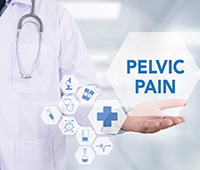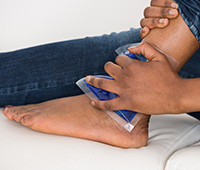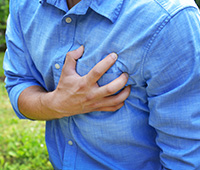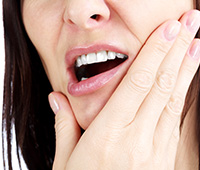WHAT IS Pelvic Pain
- Definition
- Causes
- Symptoms
- Diagnosis
- Ayurvedic Tips
- FAQS
- References
Definition

Pelvic pain is a general term used to describe pain that occurs mostly in the region below the stomach, i.e. region between your legs and lower area of stomach, known as pelvis or pelvic area. This is a common type of pain which can be long-lasting (more than 6 months) or severe (sudden and short-lived). Severe pelvic pain can interfere with daily living and functioning.1
Pelvic pain is seen most commonly in women, where they may feel dull pain during their period or sexual activity. Pelvic pain can be a sign that there is a problem with one of the organs in the pelvic area, such as the womb, eggs, reproductive tubes, birth canal or womb opening. It is reported that around 45% women suffer from long-lasting pelvic and low back pain during pregnancy in Europe. In Asia, it is considered as a normal side effect of pregnancy.3
Pelvic pain is less common in men and most of the times, the problem is with the prostate gland (a gland surrounding the urinary bladder in men).2
According to Ayurveda, when a woman of vata prakriti consumes an improper diet and indulges in other activities that aggravate vata; aggrevated Vata reachesthe reproductive system, and produces pricking and pelvic pain, stiffness, sensation like creeping of ants, roughness, numbness and tiredness. Due to vata, periods become irregular and are often painful, frothy, thin, and dry (absence of mucous).4
Disclaimer: The information on this page is not intended to be a substitute for professional medical advice. Do not use this information to diagnose or ayurvedic treatment of pain and/or pelvic pain without consulting the doctor. Consult your physician before beginning an exercise regime. "While we have products /ayurvedic medicines for pain and/or pelvic pain, you must consult an authorized physician before taking any of the products. For more information on products, visit www.dabur.com or call 1800-103-1644"
Causes
Causes OF Pelvic Pain
The following health problems can cause pelvic pain: 1
Adhesions: Adhesions are bands of tissue that form between internal tissues and organs, and keep them from shifting easily as the body moves. They can form as a result of surgery or infections.
Endometriosis: A condition where endometrial tissue (tissue lining the inside of the uterus) is also presnt outside the uterus (womb) . Common sites where endometrial tissue can grow outside uterus are Ovaries, Fallopian tubes (tubes that carry egg from ovaries to uterus), areas in front , back and to the sides of the uterus. The two most common symptoms of endometriosis are pain and may have infertility (inability to conceive).
Painful Bladder disorder: This condition causes bladder pain, and a need to urinate often and right away. It may appear as a burning or sharp pain in the bladder or at the opening where urine leaves the body.
Irritable bowel disorder: This is a digestive problem that can cause pain, bloating, constipation, or diarrhea.
Pelvic floor pain: These conditions occur when the muscles and connective tissues that hold all the pelvic organs in place, get weakened or are injured. Pelvic floor disorders can cause discomfort and pain as well as functional problems, such as trouble with urination, constipation, pain with intercourse.
Uterine fibroids: These are non-cancer tumors made of muscle cells and other tissues that grow within and around the wall of the womb. Symptoms can include heavy or painful periods, pain during sex, and lower back pain.
Among all these causes described above, Ayurveda emphasises upon endometriosis as one of the most common causes of pelvic pain. In endometriosis, excessive intake of dry food, and other factors, aggravates vata dosha. This affects the menstrual cycle, and increases the quantity and flow of blood discharged during period. The description of menstrual blood during this phase is described as phenil (frothy), tanu (thin), ruksha (dry), styana (heavy flow), aruna (rustic red), or color of decoction of kimshuka flower. There is severe pain in lower back, chest, pelvis and stomach.4
Disclaimer: The information on this page is not intended to be a substitute for professional medical advice. Do not use this information to diagnose or ayurvedic treatment of pain and/or pelvic pain without consulting the doctor. Consult your physician before beginning an exercise regime. "While we have products /ayurvedic medicines for pain and/or pelvic pain, you must consult an authorized physician before taking any of the products. For more information on products, visit www.dabur.com or call 1800-103-1644"
Symptoms
Symptoms OF Pelvic Pain
Pelvic pain in women is presented in many ways. Some common symptoms include:1
- Steady pain or on & off kind of pain in the lower stomach area
- Sharp and stabbing pain felt in a specific spot, or a dull pain that is spread out.
- Pain that occurs only during menstrual periods.
- Pain while using the bathroom
- Pain while lifting something heavy
- Pain in the vulva (the external genitals) during sexual activity
Disclaimer: The information on this page is not intended to be a substitute for professional medical advice. Do not use this information to diagnose or ayurvedic treatment of pain and/or pelvic pain without consulting the doctor. Consult your physician before beginning an exercise regime. "While we have products /ayurvedic medicines for pain and/or pelvic pain, you must consult an authorized physician before taking any of the products. For more information on products, visit www.dabur.com or call 1800-103-1644"
Diagnosis
Diagnosis OF Pelvic Pain
Your doctor will ask you for your medical history and a complete description of pain to help identify the type of pain and its cause. Your doctor may also perform a physical examination of the stomach and pelvis, your organs, and muscles and tissues in the pelvic region to check for tenderness or abnormalities. Some diagnostic tests may be suggested, such as:
- Lab tests: such as blood work or a urine test
- Pelvic ultrasound: a procedure that uses sound waves to look at organs and structures inside the pelvic region
- Pelvic laparoscopy: a minor surgery in which the doctor inserts a viewing instrument called a laparoscope through a small cut in the skin below the belly button to look inside the pelvis
- Pelvic MRI, (magnetic resonance imaging) scan: an imaging test that uses powerful magnetic and radio waves to create pictures of the pelvis
- Cystoscopy: looking into the bladder by inserting a viewing instrument
- Colonoscopy: looking into the bowel (intestines) by inserting a viewing instrument
Disclaimer: The information on this page is not intended to be a substitute for professional medical advice. Do not use this information to diagnose or ayurvedic treatment of pain and/or pelvic pain without consulting the doctor. Consult your physician before beginning an exercise regime. "While we have products /ayurvedic medicines for pain and/or pelvic pain, you must consult an authorized physician before taking any of the products. For more information on products, visit www.dabur.com or call 1800-103-1644"
Ayurvedic Tips
Ayurvedic Tips Pelvic Pain
Your doctor will ask you for your medical history and a complete description of pain to help identify the type of pain and its cause. Your doctor may also perform a physical examination of the stomach and pelvis, your organs, and muscles and tissues in the pelvic region to check for tenderness or abnormalities. Some diagnostic tests may be suggested, such as:
- Lab tests: such as blood work or a urine test
- Pelvic ultrasound: a procedure that uses sound waves to look at organs and structures inside the pelvic region
- Pelvic laparoscopy: a minor surgery in which the doctor inserts a viewing instrument called a laparoscope through a small cut in the skin below the belly button to look inside the pelvis
- Pelvic MRI, (magnetic resonance imaging) scan: an imaging test that uses powerful magnetic and radio waves to create pictures of the pelvis
- Cystoscopy: looking into the bladder by inserting a viewing instrument
- Colonoscopy: looking into the bowel (intestines) by inserting a viewing instrument
Diet Recommendations (Aahar)
Ayurveda recommends strict following of Ojas- body building foods, and to avoid the foods that reduce the Ojas. This is critical as it regulates ovulation and enhances fertilization in conditions like endometriosis, thereby reducing suffering by pain.
- Food such as ghee, milk, nuts, dates, sesame seeds, pumpkin seeds, saffron, honey, and avocados help replenish and build Ojas.
- Fresh, organic fruits and vegetables, whole grains, protein from plant sources (like beans, peas), sweet and juicy fruits (like mangoes, peaches, plums, and pears), asparagus, broccoli, and spices (like ajwain powder, cumin to purify the uterus in women, turmeric to improve the interaction between hormones and targeted tissues, and black cumin for boosting fertility.
- Root vegetables, grains, arugula, watercress, onions, garlic, and chives improve circulation and nourish the blood.
- Urad dhal cooked with equal parts turmeric, cumin, coriander and fennel or banana cooked in ghee, cinnamon and cardamom for enhancing fertility.
- Black sesame seeds and jaggery are both rich sources of vitamin E and iron, and help with causing positive changes in the female body.
- Spinach, beans, pumpkin, tomatoes, and beets, boost iron and promote fertility.
Lifestyle changes (Vihar)
Exercise, yogasana and meditation can help strengthen the pelvic, stomach and lower back muscles, and improve fertility in both females and males. Few yogasanas beneficial for the pelvic muscles are:
 Uttanpadasana
Uttanpadasana Supta Pawanmuktasana
Supta Pawanmuktasana Chakki Chalanasa (churning the mill)
Chakki Chalanasa (churning the mill)
Disclaimer: The information on this page is not intended to be a substitute for professional medical advice. Do not use this information to diagnose or ayurvedic treatment of pain and/or pelvic pain without consulting the doctor. Consult your physician before beginning an exercise regime. "While we have products /ayurvedic medicines for pain and/or pelvic pain, you must consult an authorized physician before taking any of the products. For more information on products, visit www.dabur.com or call 1800-103-1644"
FAQS
FAQS
1. Can Ayurveda treat foot pain?
In Ayurveda, foot care is considered very important since it is known to benefit the entire body and nervous system in a holistic manner. There are certain points in our body called marma or vital points, where our vital energies are concentrated. Feet and ankles also have these vital points, which if not taken care of, can cause problems like chronic pain in the ankles, pain and swelling in feet, etc. Ayurveda can play a significant role in managing ankle pain with a combination of corrective Ahar (diet), Vihar (exercise) and Aushadhi (Medicines) regime.
2. What kind of diet and exercises will be helpful in reducing neck pain?
To reduce neck pain, Ayurveda suggests following diet and exercises:
- Take lots of fruits, green vegetable salads and sprouts.
- Good hydration will help retain neck health.
- Avoid refined foods and junk foods.
- Milk is an important source of Calcium and can help maintain healthy bones.
- Vitamin C in citrus fruits will help the healing process.
- Honey in warm water or herbal teas are good for cleansing the bowels and this will help relieve many backaches that are due to constipation.
Pranayama (breathing exercises) is a powerful way to promote relaxation and a pivotal first step towards relieving muscle tension. Slow, deep breathing & relaxation can stimulate a sense of calmness and cause reduction in pain.
Yoga Asanas are also beneficial in maintaining neck and overall health
- Balasana
- Marjaryasana
- Bhujangasana
3. I have knee pain. What could be the reasons for it?
Knee pain can have different causes. Being overweight puts you at greater risk for knee problems. Overusing your knee can trigger knee problems that cause pain. If you have a history of arthritis (swelling of knee joint), it could also cause knee pain.
Medical conditions that can cause knee pain are
- Arthritis – Rheumatoid arthritis, Osteoarthritis, Gout
- Infection in the knees / knee joint
- Injuries – fracture, dislocation, sprained knees etc.
- Cancer
4. What can I do to reduce my knee pain?
Ayurveda suggests following diet and lifestyle changes to help reduce knee pain.
Include more foods containing
- Pulses: Black gram, green gram
- Vegetables & spices: Onion, garlic, sesame seeds, ginger, radish, ladies finger, pumpkin
- Fruits: pomegranate, mango, grapes
- Oils: Ghee
Ayurveda recommends regular, slow and gentle exercises with adequate rest to knee joints. Regular Pranayama and Yoga Nidra is also recommended.
- Avoid prolonged walking, standing, kneeling and squatting and crossed leg sitting.
- Yoga asanas: Makarasana, Pavanamuktasana, Dhanurasana, Vakrasana
5. I have tingling pain in the legs. Is it sciatica?
Sciatic pain most often occurs on one side of leg or hip. Symptoms of sciatica pain can vary widely as mentioned below:
- Mild tingling
- Dull aching that radiates from buttock to back of whole leg
- Burning sensation
- Inability to move leg when pain becomes severe
The pain often starts slowly and may get worse:
- After standing or sitting
- At night
- When sneezing, coughing, or laughing
6. What diet is effective in reducing the sciatica pain?
A healthy diet for controlling sciatica pain is for balancing Vata dosha and includes:
- Grains: Rice, cooked oatmeal, whole wheat and whole grain breads (toasted)
- Pulses: Yellow split mung beans (green skin removed), whole mung beans, red lentils and tofu
- Vegetables: : Zucchini, asparagus, carrot, beets, sweet potatoes, cucumber, lady finger, parsley, green peas, fennel, spinach in small amounts and cooked coconut. All should be cooked well so they are soft.
- Spices: Cumin, ginger, mustard seeds, ajwain, celery seeds, fenugreek, coriander, bay leaves, basil, saffron, hing (asafoetida), cinnamon, cardamom, cloves, anise, fennel, black pepper (in small amounts)
- Fruits: All ripe, sweet, and juicy fruits. Sweet grapes, banana, melons, plums, cherries, mango, papaya, pomegranate, sweet pineapples, raisins, sweet oranges, dates and figs, avocado, apples and pears.
- Oils: Ghee or organic olive oil
- Sweeteners: Honey, jaggery, date sugar
7. I frequently get gas pain. What food types are good for me?
Following foods are good to help relieve gas pain:
- Grains: Whole wheat thick flat bread or chapati, millet & sorghum bhakri, unpolished rice
- Pulses: Chickpea, Tur dal, Masoor Moong
- Vegetables: Carrots, Radish, Lauki, potatoes, white gourd, spiny gourd, , cucumber, ajwain, guar bean, eggplant, amaranth, cabbage, spinach, coriander seeds and leaves, sweet potatoes, tomatoes, green chillies, lady finger
- Fruits: , pears, papaya, pineapple, pomegranate, oranges, unripe bananas, water chestnut, dry fruits – almonds, walnuts, peanuts, dry dates, apples, grapes etc.
- Oils: Ghee, coconut oil in small quantities
- Ginger, cumin, coriander should be preffered in spices.
8. What is trigeminal neuralgia?
Trigeminal nerve (TN) pain is a nerve condition that causes a stabbing or electric-shock-like pain in parts of the face.
It usually affects one side of the face. Any vibration on your face, even from talking, brushing etc. can set it off. The condition may come and go, disappearing for days or even months. But the longer you have it, the less often it goes away. TN pain usually affects women and people above 50 years of age.
Ayurveda describes 11 types of shiro rogas (headaches), among which trigeminal nerve type of pain is called ‘Ardhavabhedaka’. It happens when aggravated doshas (Vata, Pitta and Kapha) press on the neck and throat producing a powerful burning sensation, out of which comes excruciating pain. This pain ultimately affects the eyes, eyebrows and temples.
9. How can Ayurveda help in relieving stomach pain?
Ayurveda describes a comprehensive approach towards managing stomach pain- the most commonly diagnosed conditions being constipation (Vibandha) and indigestion (Ajirna)
Constipation is used to indicate fewer bowel movements, hard stools, painful defection and feeling of bloating, abdominal pain or incomplete elimination.
Indigestion, on the other hand, is an abnormality that occurs in digesting food or lack of proper digestion resulting in stomach pain, burping or flatulance (abdominal gas).
Ayurveda can play a significant role in managing & preventing different stomach pains by practising a combination of corrective Ahar (diet), Vihar (exercise) and Aushadhi (Medicines) regime
Corrective Ahar for both constipation & indigestion includes:
Grains: Wheat, unpolished rice, barley
- Pulses: Green gram, chickpeas, course corn, Toor dal, moong, masura lentils, Vegetables/Spices: Garlic, Asafetida, long pepper, sunthi (dry ginger), green leafy vegetables, cucumber, bitter gourd, pointed gourd, cabbage, dates, betel nut, turmeric
- Fruits: High fibre fruits such as apples, pears, papaya, grapes, amala, haritaki
- Oils: Ghee
Exercise: Regular exercise, meditation and practice of asanas purifies the blood, improves the appetite, increases the will power and makes the patient physically active. The whole alimentary canal improves and becomes regular.
Yoga Asanas: Vajrasana (after every meal), Kurmasana, Vakrasana, Katichakrasana
Pranayama: Surya anulom viloma, deep relaxation technique
10. What is myofasial pain?
Myofascial pain disorder (MPS) refers to pain and swelling in the body's soft tissues or muscles. Myofascial pain is a long-term, painful condition that affects the connective tissue that cover the muscles. It is considered as a type of muscular pain (fibromyalgia) which happens at specific areas on the body.
Myofascial pain might involve either a single muscle or an entire muscle group. In some cases, the area where you experience the pain might not be where the myofascial pain is generated. The actual location of the injury leads to the development of a trigger point, which in turn causes pain in other areas. This is known as referred pain
Disclaimer: The information on this page is not intended to be a substitute for professional medical advice. Do not use this information to diagnose or ayurvedic treatment of pain and/or pelvic pain without consulting the doctor. Consult your physician before beginning an exercise regime. "While we have products /ayurvedic medicines for pain and/or pelvic pain, you must consult an authorized physician before taking any of the products. For more information on products, visit www.dabur.com or call 1800-103-1644"
References
References
Pelvic Pain: Overview. NIH & NICHD. [Reviewed 2013 December 4]. [Cited 2016 September 3]. Available at: https://www.nichd.nih.gov/health/topics/pelvicpain/Pages/default.aspx
2. Pelvic Pain. MedLine Plus. [Cited 2016 September 3]. Available at: https://medlineplus.gov/pelvicpain.html
3. Gupta M, et al. PREVALENCE OF PREGNANCY RELATED PELVIC GIRDLE PAIN IN INDIAN PRIMIGRAVIDA: A TERTIARY CARE HOSPITAL BASED STUDY. Indian Journal of Obstetrics and Gynecology Research Vol.1, No.1, October 2014.16-23
4. Kokate KK, Kulkarni NG. Endometriosis in Ayurvedic Perspective. Journal of Homeopathy & Ayurvedic Medicine. 2013 Dec 16;2013.
5.Karamchedu S. Women’s Infertility-An Ayurvedic Perspective.2013 April 3. Available at: http://www.ayurvedacollege.com/sites/ayurvedacollege.com/files/articles/Women's-Infertility-SirishaKaramchedu.pdf
Saraswati SS. Asana pranayama mudra bandha. 2009 Jan 1.
Disclaimer: The information on this page is not intended to be a substitute for professional medical advice. Do not use this information to diagnose or ayurvedic treatment of pain and/or pelvic pain without consulting the doctor. Consult your physician before beginning an exercise regime. "While we have products /ayurvedic medicines for pain and/or pelvic pain, you must consult an authorized physician before taking any of the products. For more information on products, visit www.dabur.com or call 1800-103-1644"




